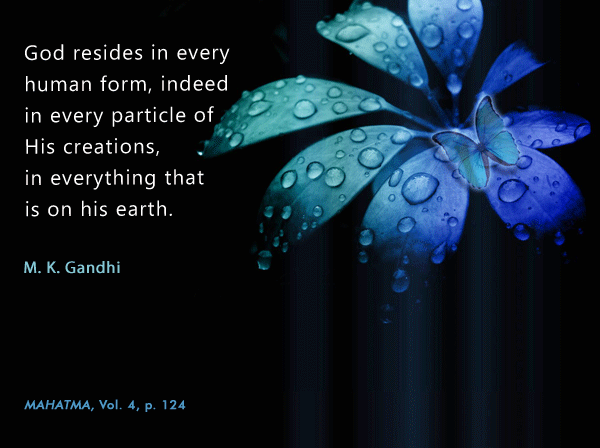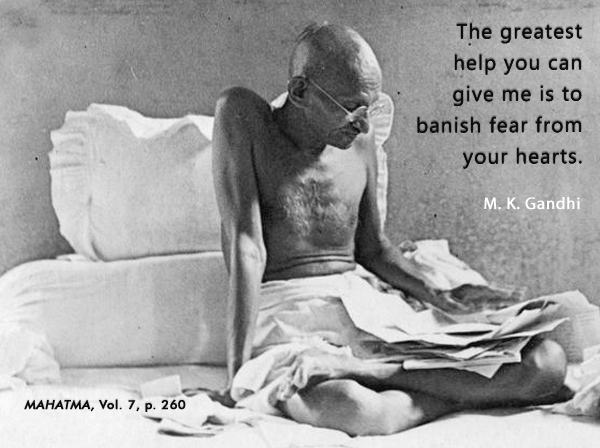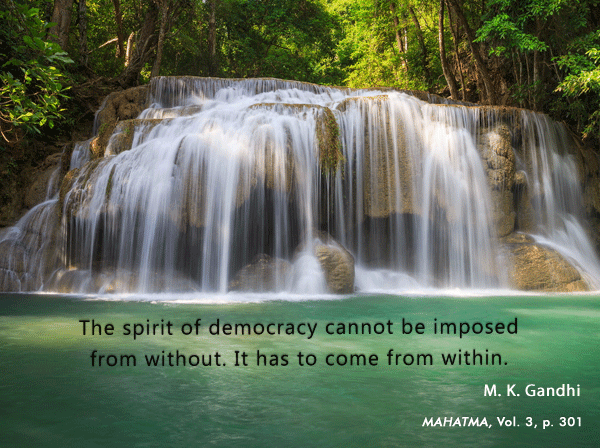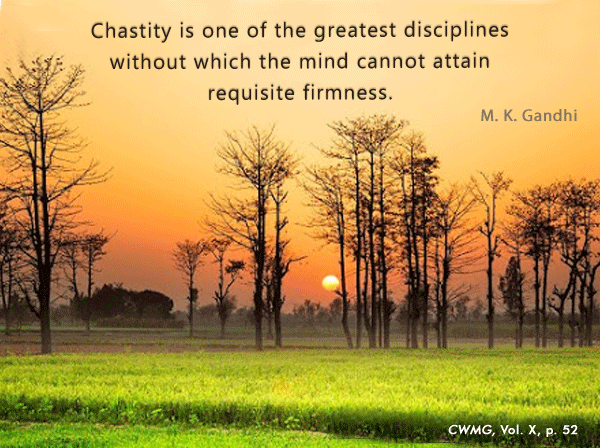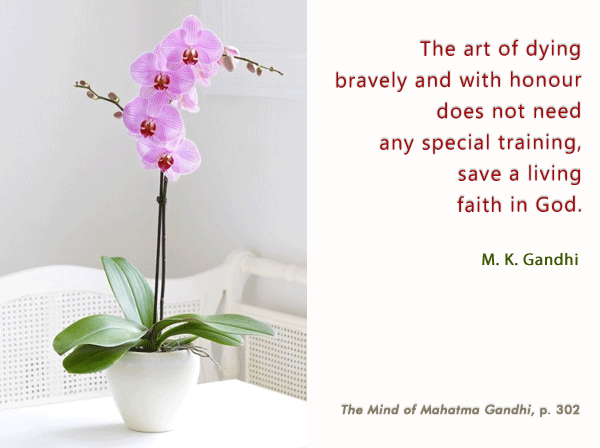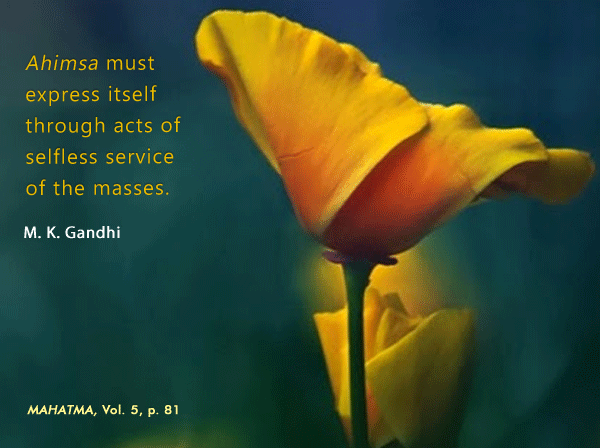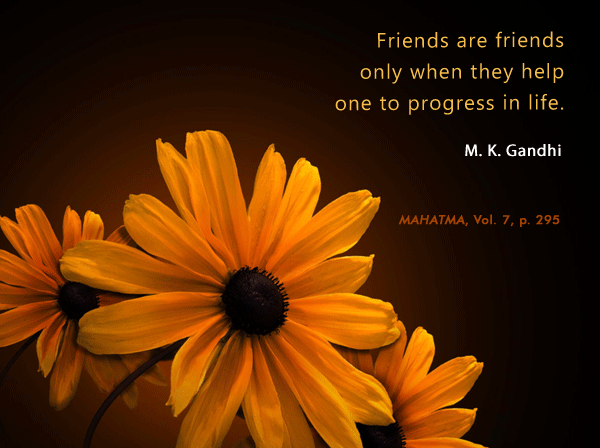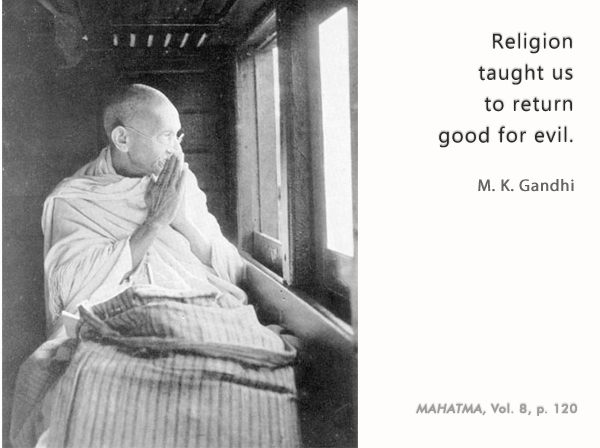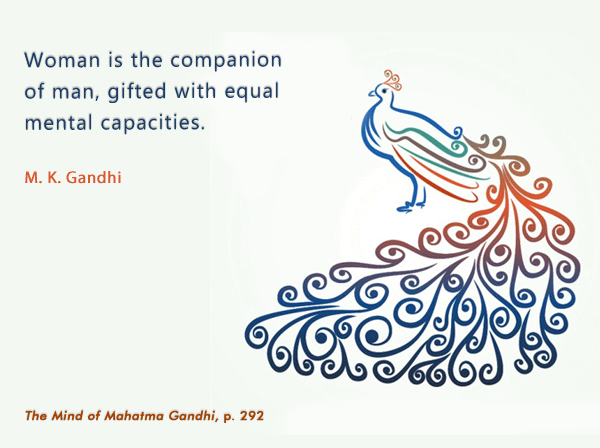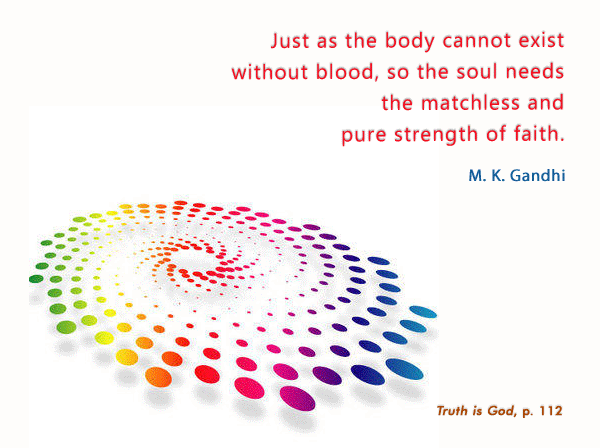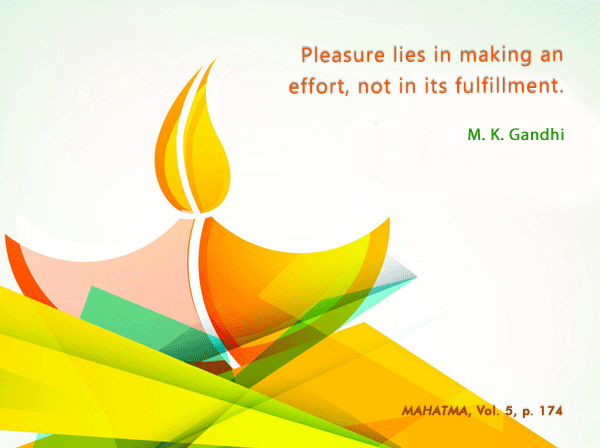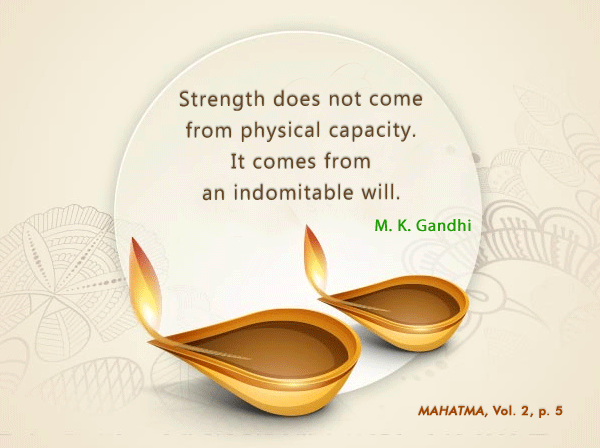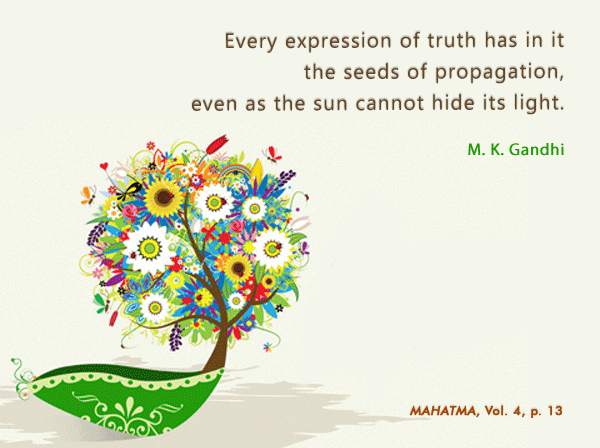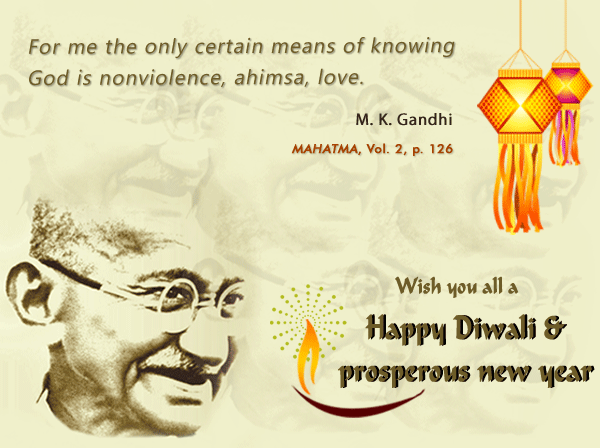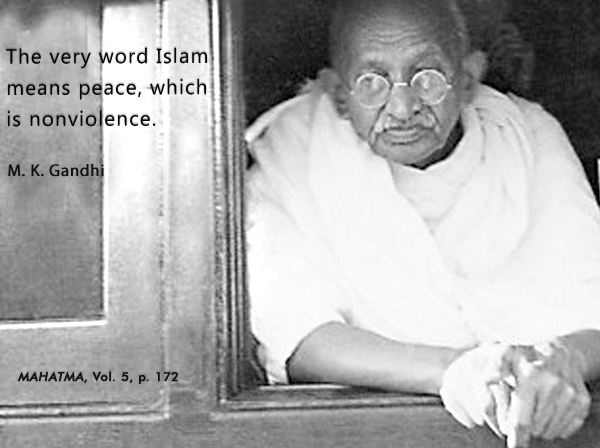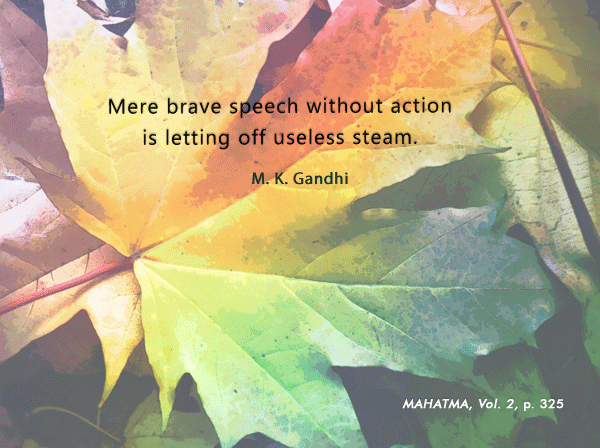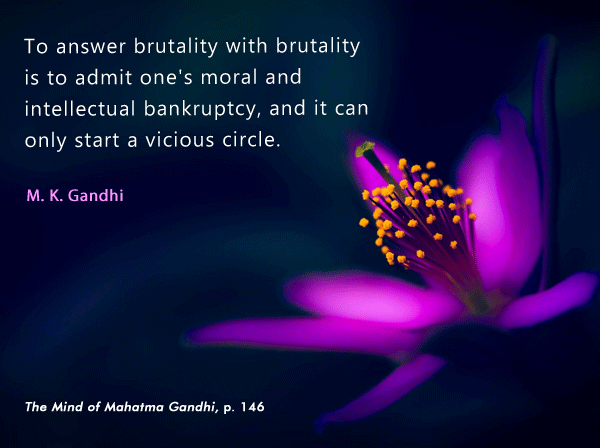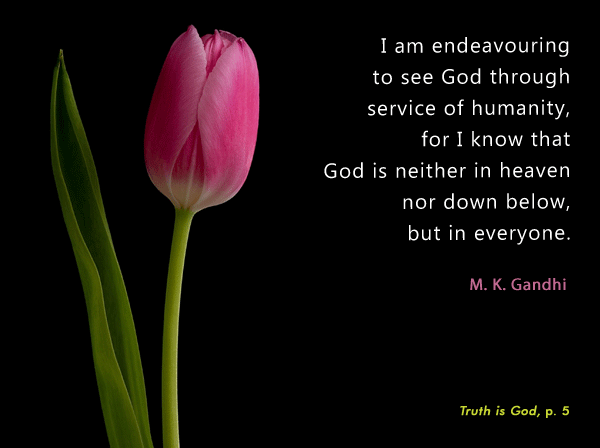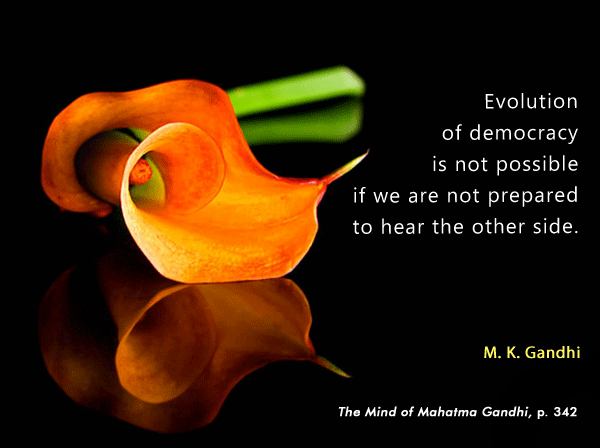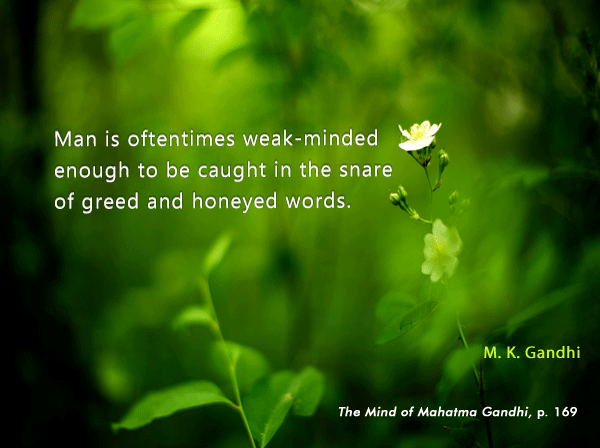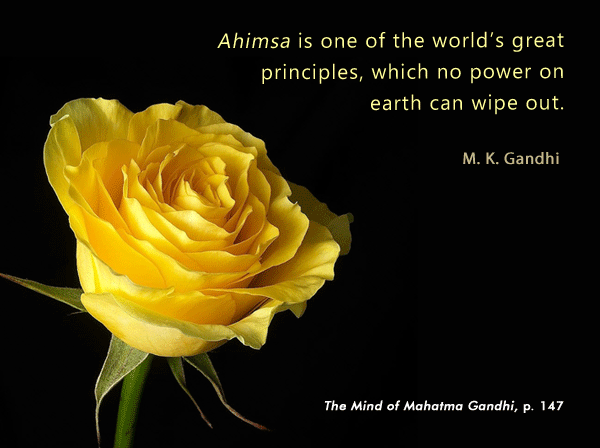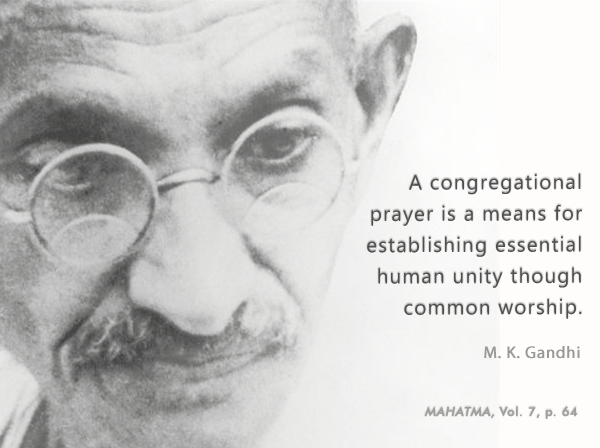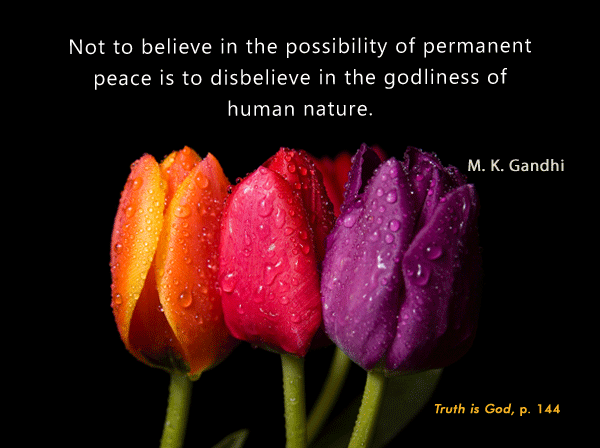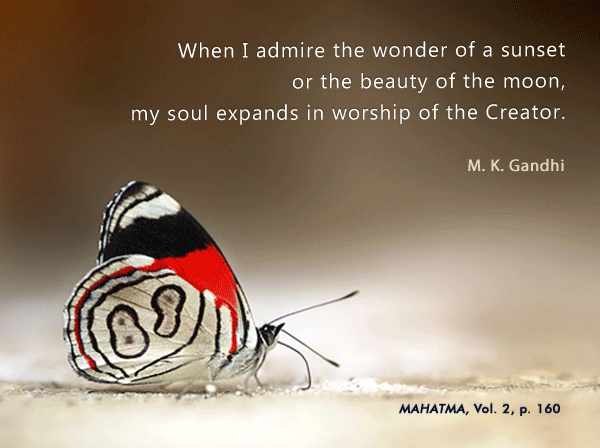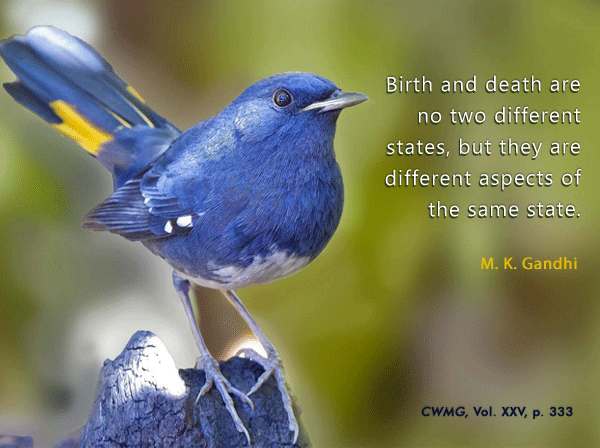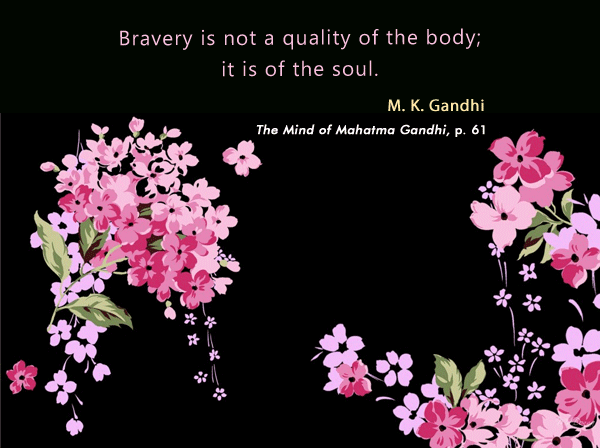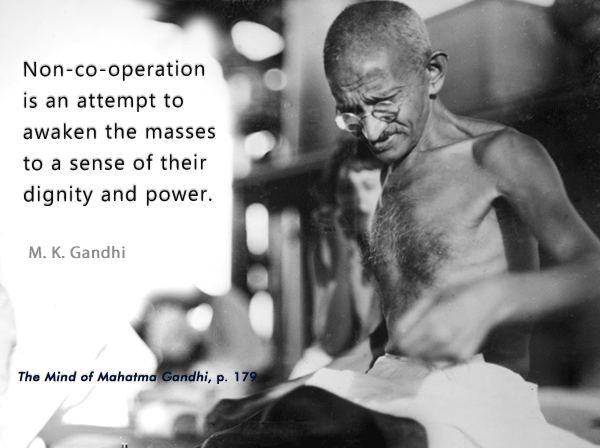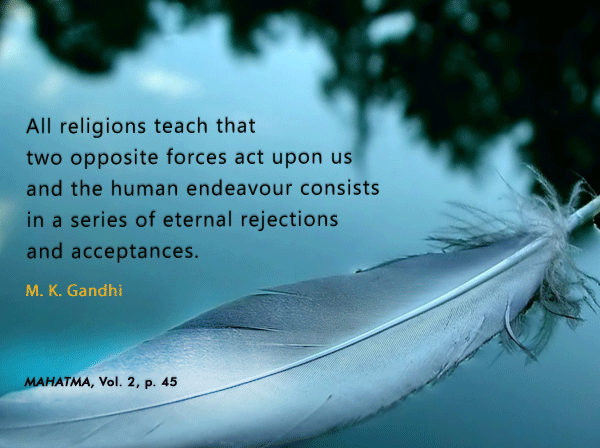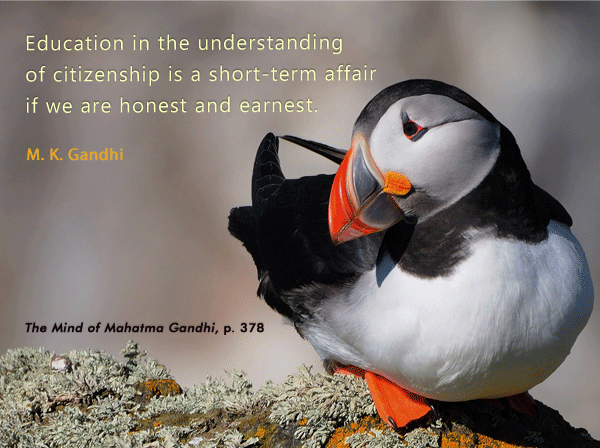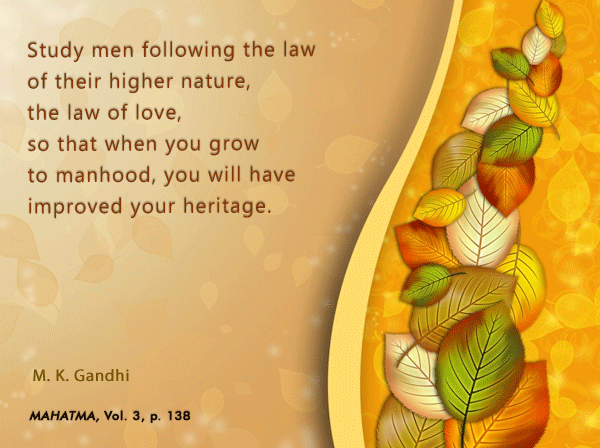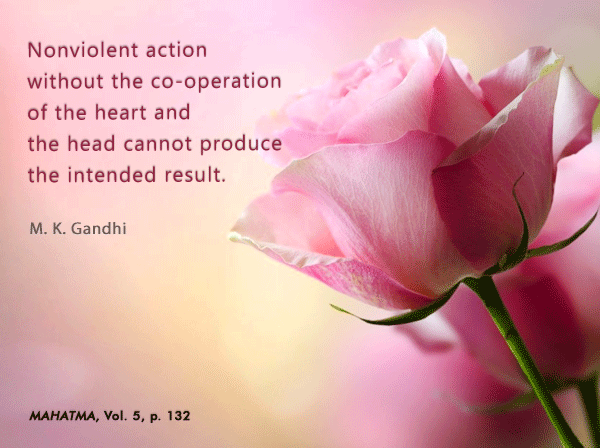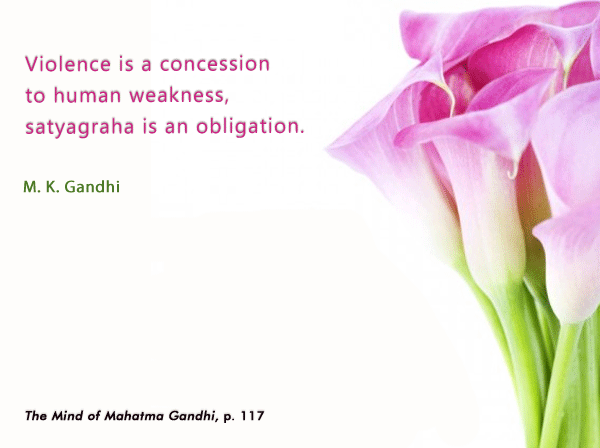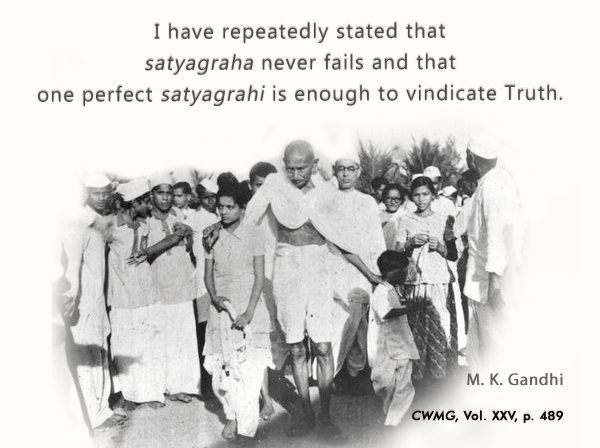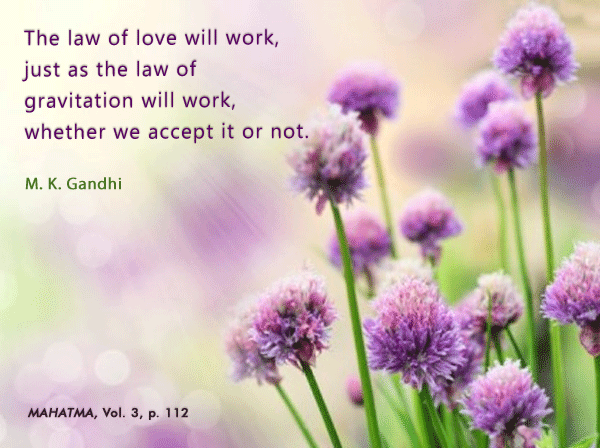Tuesday, November 24, 2015
Monday, November 23, 2015
Saturday, November 21, 2015
Friday, November 20, 2015
Thursday, November 19, 2015
Wednesday, November 18, 2015
Tuesday, November 17, 2015
Monday, November 16, 2015
Sunday, November 15, 2015
Saturday, November 14, 2015
Friday, November 13, 2015
Thursday, November 12, 2015
Wednesday, November 11, 2015
Tuesday, November 10, 2015
Monday, November 9, 2015
Gandhi Journal Article-II (November 2015)
Gandhi Journal Article-II (November 2015)
Gandhi on theory and practice of Islam
By Dr. Anupma Kaushik
The word Islam means peace but today it invokes images of violence, totalitarianism and irrationality. (Afkhami, 1995, 33) Islam is one religion which of late has been associated with terrorism and fundamentalism worldwide. Names like ISIS, Boko Harem, Al Qaeda, Taliban, Al-Shabaab, have become synonym with fundamentalism and terrorism. (Times of India, 2015, 10) The troubled spots in the world today such as Pakistan, Iraq, Somalia, Yemen, Syria, Libya and Afghanistan where violence and fundamentalism have disturbed peace are mostly associated with Islam. (The Hindu, 2015, 12) This raises the question whether Islam is a peaceful religion or not? However this is not a new question for a country like India which had a huge Muslim population living with people of other religions at times peacefully but at others not so peacefully. Even in pre independence era leaders like Gandhi had to deal with this issue.
READ FULL ARTICLE
Sunday, November 8, 2015
Saturday, November 7, 2015
"Nonviolence, the only short-cut"
"Nonviolence, the only short-cut"
“I do not believe in short-violent-cuts to success.”
–Gandhi (Harijan, December 11, 1924)
The Global War on Terror tries to sell us the false idea that we can effectively fight terrorism by killing “terrorists,” instead of addressing the conditions that led to terrorism in the first place. A “short-violent-cut to success,” instead of addressing economic inequality, lack of basic needs like education: that’s long-term work. More difficult, costly, the advocates of violent means proclaim. Why do some of us believe them?
Maria Montessori would suggest, have a look at the way we interact with children. What do we believe is the best way to deal with a tantrum or so-called misbehavior from a child? Perhaps, say, the child has broken a household agreement--or a household item. What do you do? Punish them? Isolate them, as we would send someone to prison? These are our version of “short-violent-cuts to success.” Maybe the tantrum stops, maybe they stay in their room for hours. What did they learn? To become a better communicator, to know how to meet their needs? Or simply that some people have more power than others and they can use that power to get their way? Where there was an opportunity for real transformation–the kind that nonviolence alone can bring about–these short-cuts some parents take daily over time lead children, future grown-ups, to accept these kinds of dynamics in their dealings with others — and go on to raise more children along the same lines. It can give us a keen insight into how we might go beyond violence in our political dealings. Violent short-cuts often lead us into quagmires.
Montessori’s and Gandhi’s ideas were more than a hunch; they were convictions based on their personal experience. But where’s the data to prove it, some might still ask. Professor of Terrorist Studies, Erica Chenoweth, conducted a now world-famous study with Prof. Maria Stephan on the success of nonviolent campaigns worldwide as compared with violent ones. What they found added quantitative support to their convictions: Nonviolent campaigns are twice as likely to succeed than violent ones, and take less time (3 years as opposed to roughly 9). The case is made: the only viable short-cut to success is nonviolence.
Experiment in Nonviolence:
How can we develop the habit of looking realistically at the long term when we’re facing a conflict or some kind of personal problem?
Courtesy: www.mettacenter.org
“I do not believe in short-violent-cuts to success.”
–Gandhi (Harijan, December 11, 1924)
The Global War on Terror tries to sell us the false idea that we can effectively fight terrorism by killing “terrorists,” instead of addressing the conditions that led to terrorism in the first place. A “short-violent-cut to success,” instead of addressing economic inequality, lack of basic needs like education: that’s long-term work. More difficult, costly, the advocates of violent means proclaim. Why do some of us believe them?
Maria Montessori would suggest, have a look at the way we interact with children. What do we believe is the best way to deal with a tantrum or so-called misbehavior from a child? Perhaps, say, the child has broken a household agreement--or a household item. What do you do? Punish them? Isolate them, as we would send someone to prison? These are our version of “short-violent-cuts to success.” Maybe the tantrum stops, maybe they stay in their room for hours. What did they learn? To become a better communicator, to know how to meet their needs? Or simply that some people have more power than others and they can use that power to get their way? Where there was an opportunity for real transformation–the kind that nonviolence alone can bring about–these short-cuts some parents take daily over time lead children, future grown-ups, to accept these kinds of dynamics in their dealings with others — and go on to raise more children along the same lines. It can give us a keen insight into how we might go beyond violence in our political dealings. Violent short-cuts often lead us into quagmires.
Montessori’s and Gandhi’s ideas were more than a hunch; they were convictions based on their personal experience. But where’s the data to prove it, some might still ask. Professor of Terrorist Studies, Erica Chenoweth, conducted a now world-famous study with Prof. Maria Stephan on the success of nonviolent campaigns worldwide as compared with violent ones. What they found added quantitative support to their convictions: Nonviolent campaigns are twice as likely to succeed than violent ones, and take less time (3 years as opposed to roughly 9). The case is made: the only viable short-cut to success is nonviolence.
Experiment in Nonviolence:
How can we develop the habit of looking realistically at the long term when we’re facing a conflict or some kind of personal problem?
Courtesy: www.mettacenter.org
Friday, November 6, 2015
Gandhi Journal Article-I : November 2015
Gandhi Journal Article-I (November 2015)
Mahatma Gandhi and Bhagat Singh : A Clash of Ideology
By Jai Narain Sharma
Great men of all generations have been anxious about improvement of the lot of human beings. But how to realize it remains a formidable task for every age. Even though the goal is similar, the means to achieve the goal can differ. And this difference in approach can generate a lot of controversy. This is precisely what happened between Mahatma Gandhi and Sardar Bhagat Singh, the two great statesmen of modern India. As a result, Bhagat Singh has been ranked as a rival of Mahatma Gandhi. It has been held in some quarters that while Gandhi was the sun of nationalism around which all the planets of the Indian National Congress revolved, Bhagat Singh was a star that pursued an orbit of its own.
READ FULL ARTICLE
The opposite of love
The opposite of love
“I am trying every moment of my life to be guided by ahimsa, by love.”
–Gandhi (Harijan, January 12, 1934)
Hafiz asked Rabia, "O Daughter of God, is hate the opposite of love?" She replied, “No. Love has no opposite.”
Rabi’a, the 7th Century mystic from Basra (not yet Iraq) and founder of the Sufi movement, was voicing the very vision that would be foundational for Gandhi: that the world is based on sat ‘Truth, reality, the good’ so that in the long run nonviolence has got to prevail, and any victory of violence, which denies love, which is the expression of asat or unreality “is out of the question.”
Nonviolence, which in the fullest sense is ultimately rooted in this vision, invites us to take our destinies into our own hands and actively embrace our highest values.
Love, Gandhi found, is a guide. Every moment.
Another Sufi mystic, Ansari of Herat, still centuries before the Mahatma, warned, Watch vigilantly the state of thine own mind, love of God begins in harmlessness. Ahimsa.
This is an extremely high calling; an ideal. But we can work at it daily, moment by moment, trying to be vigilant not toward others, but toward oneself, our own motivations, words and even smallest actions. And when we do, love-energy, nonviolence, can move through us freely. Nothing can stop it. What it can lead to in the end has been described, I think without exaggeration, as becoming love itself, union with what is Real, being completely natural, fully human.
Experiment in Nonviolence:
Without letting yourself get too self-conscious, set aside some time to ‘watch vigilantly:’ what were your motivations today?
Courtesy: www.mettacenter.org
“I am trying every moment of my life to be guided by ahimsa, by love.”
–Gandhi (Harijan, January 12, 1934)
Hafiz asked Rabia, "O Daughter of God, is hate the opposite of love?" She replied, “No. Love has no opposite.”
Rabi’a, the 7th Century mystic from Basra (not yet Iraq) and founder of the Sufi movement, was voicing the very vision that would be foundational for Gandhi: that the world is based on sat ‘Truth, reality, the good’ so that in the long run nonviolence has got to prevail, and any victory of violence, which denies love, which is the expression of asat or unreality “is out of the question.”
Nonviolence, which in the fullest sense is ultimately rooted in this vision, invites us to take our destinies into our own hands and actively embrace our highest values.
Love, Gandhi found, is a guide. Every moment.
Another Sufi mystic, Ansari of Herat, still centuries before the Mahatma, warned, Watch vigilantly the state of thine own mind, love of God begins in harmlessness. Ahimsa.
This is an extremely high calling; an ideal. But we can work at it daily, moment by moment, trying to be vigilant not toward others, but toward oneself, our own motivations, words and even smallest actions. And when we do, love-energy, nonviolence, can move through us freely. Nothing can stop it. What it can lead to in the end has been described, I think without exaggeration, as becoming love itself, union with what is Real, being completely natural, fully human.
Experiment in Nonviolence:
Without letting yourself get too self-conscious, set aside some time to ‘watch vigilantly:’ what were your motivations today?
Courtesy: www.mettacenter.org
Thursday, November 5, 2015
"What a smile did"
"What a smile did"
“Not an ounce of nonviolent energy is ever wasted.”
“Not an ounce of nonviolent energy is ever wasted.”
–Gandhi (Harijan, January 11, 1948)
Mrs. Hartsough (the mother of one of my nonviolence mentors, David Hartsough) stood day after day in front of Hanford WA nuclear plant, to try to reach the conscience of those who worked there with a group of other ordinary people who realized that nuclear would mean danger to persons and the environment. Usually no one would greet them, and she thought for years after that their actions did not have any effect. One day, however, she found herself in line at a local grocery store when the man in front of her turned to her, as if he recognized her from somewhere. “Did you by any chance protest at the entrance of the Hanford nuclear plant twenty years ago?” he asked. “Why yes, I did,” she replied. “Well, you don’t know me, but I used to work there. And they told us that we shouldn’t make eye-contact with you people. But one day, I looked at you. And you smiled at me. And I quit my job.”
No newspaper would have known to report on that nonviolent success, but there you have it. Even David’s mother didn’t realize that she had transformed the life of another person–with a smile where he was likely expecting a rebuke or an insult. Imagine now that this kind of action is taking place all of the time. How do we explain that?
Just weeks before he shed his body, after decades of nonviolent struggle on two continents, Gandhi quietly shared one of the most significant insights about the power of nonviolence: no amount of nonviolent energy, no matter how small or unseen, is wasted. It might not seem to have worked, but, who knows? It could have been the small act that saved a life, inspired another way to do things, or led, even, to the fall of an Empire.
Experiment in Nonviolence:
Write down today’s quote in a place that you can see it often.
Courtesy: www.mettacenter.org
Wednesday, November 4, 2015
A successful strike
“The conditions of a successful strike are simple. And when they are fulfilled, a strike need never fail.”
–M. K. Gandhi (Young India, February 16, 1921)
Would it be a surprise to learn that Gandhi was in favor of laborers and was on the side of strikers throughout his life? Of course not.
He knew, and wanted others to realize, that workers have a lot of power–it is their work that keeps the wheels of society moving. He was convinced that workers needed always to advocate for themselves to ensure dignity in their conditions and recognition of their rights. Strikes become an important tool to be used, he felt, as with any tool in the nonviolence toolkit: with discernment, which keeps the tool sharpened and powerful.
But how do you strike, according to Gandhi? Do you just stop going to work? What happens if those against whom you are striking just replace you at your job? A few years after resorting to fasting (one of the first of his career) to boost the flagging morale of striking workers in Ahmedabad in 1918, he came up with a few, energy-saving guidelines.
Here are his six rules for strike success:
1. The cause must be just.
2. There must be “practical unanimity” among all of the strikers (hence the 1918 fast).
3. No violence should be used against any non-strikers.
4. Strikers should not draw from union funds during the strike, but turn instead to some “useful and productive temporary occupation.”
5. If there is enough labor to simply replace the strikers, then a strike will not work. Resignation is the way forward, instead.
6. Follow all rules 1-5, without overlooking or ignoring any of these recommendations.
You have to love that last one.
Experiment in Nonviolence:
Based on his list about strikes, can you anticipate what might be some of Gandhi’s guidelines for resignation as a tool of nonviolent strategy?
Courtesy: www.mettacenter.org
–M. K. Gandhi (Young India, February 16, 1921)
Would it be a surprise to learn that Gandhi was in favor of laborers and was on the side of strikers throughout his life? Of course not.
He knew, and wanted others to realize, that workers have a lot of power–it is their work that keeps the wheels of society moving. He was convinced that workers needed always to advocate for themselves to ensure dignity in their conditions and recognition of their rights. Strikes become an important tool to be used, he felt, as with any tool in the nonviolence toolkit: with discernment, which keeps the tool sharpened and powerful.
But how do you strike, according to Gandhi? Do you just stop going to work? What happens if those against whom you are striking just replace you at your job? A few years after resorting to fasting (one of the first of his career) to boost the flagging morale of striking workers in Ahmedabad in 1918, he came up with a few, energy-saving guidelines.
Here are his six rules for strike success:
1. The cause must be just.
2. There must be “practical unanimity” among all of the strikers (hence the 1918 fast).
3. No violence should be used against any non-strikers.
4. Strikers should not draw from union funds during the strike, but turn instead to some “useful and productive temporary occupation.”
5. If there is enough labor to simply replace the strikers, then a strike will not work. Resignation is the way forward, instead.
6. Follow all rules 1-5, without overlooking or ignoring any of these recommendations.
You have to love that last one.
Experiment in Nonviolence:
Based on his list about strikes, can you anticipate what might be some of Gandhi’s guidelines for resignation as a tool of nonviolent strategy?
Courtesy: www.mettacenter.org
Tuesday, November 3, 2015
Gandhi and Mother Cow
Gandhi and Mother Cow
“Cow protection to me is one of the most wonderful phenomena in human evolution.”
–Gandhi (Harijan, January 1, 1925)
Cow protection. Why would Gandhi be concerned about this ancient duty to “Mother Cow”? Hint: it was about more than the cows. The practice, which he said he would “defend against the whole world,” represented, in essence, the height of ahimsa. Protection of the cow meant to him, really, the protection of all non-human life, of which the cow is only a symbol. But not an irrelevant one, given how much human beings seem to depend on her, even, he notes, more than their own mothers. But unlike our mothers, he points out, cows do not stop serving even when they die: their bones, skin, horns, intestines, every part, he notes, can be put to use. “I say this not to disparage the mother who gave us birth, but in order to show you the substantial reasons for my worshipping the cow.”
A gentle creature, Gandhi calls her, “the cow is a poem of pity,” because she relies on human goodness and care for her survival, and yet she cannot put up a protest against the demands that humans put on her, “expecting nothing but grass and grain in return.” He adds, “The appeal of the lower order of creation,” he said, “is all the more forcible because it is speechless.”
More than a superstition or passed-on folk belief, cow protection to him was one of “the most wonderful phenomena in human evolution.” All creatures can benefit from our increased sensitivity to the forces of consciousness that pervade all of life, which we come to know more and more through the daily practice of nonviolence. In the end we are as much the beneficiaries ourselves when we develop that fine sensitivity to the value of life around us.
Experiment in Nonviolence:
Apply “cow protection” to your own context. What would it look like?
Courtesy: www.mettacenter.org
Monday, November 2, 2015
We often make terrible mistakes by copying bad examples.
"We often make terrible mistakes by copying bad examples.”
–Gandhi (Young India, February 16, 1921)
There, he said it and I’m glad.
People, especially if they’re new to activism, have a tendency to copy tactics that they see others have used, but it’s harder to look beneath those tactics to the strategy they are enacting. Why is that? Unfortunately, this inability to understand strategy, is due, quite often, to a lack of one. In place of clear long-term, nonviolent strategies, people in a rush to stop the latest atrocity find themselves just imitating tactics. Whenever we act without a strategy, we might be doing a disservice to our goals and weakening other movements who would try to copy our actions in turn. ‘See a problem? Protest!’ Is that what the situation calls for? How do you know?
The Occupy Movement did not have an overarching strategy. Occupying public spaces is a tactic. Even general assemblies (GAs), even People’s Mics — these were not strategies, but tools. That didn’t last. I’m not saying that Occupy didn’t accomplish anything; not at all. But imitation can’t keep a movement going for long, as we saw. Only a strategy can do that, and might I add, a strategy that is based in principled action where one never sacrifices one’s values or the well-being of others to secure one’s own. That formula pulls at the heartstrings, in a good way.
Let’s look at an extreme, but unfortunately very real example: self-immolation. I mean, not in Gandhi’s sense of immolating one’s self-will, but the death of the body. Unfortunately, it can often be a tactic to draw extreme attention to a specific cause. Without context and strategy, the brave person who sacrifices him or herself in this way sometimes merely commits public suicide. It might draw attention to a cause, or the frustration one feels in a seemingly hopeless situation, but it often draws attention to the spectacular tactic itself and not the issue.
Same goes with public fasting.
Instead of copying tactics, we can take the time to learn, really learn from other movements, whether successful or not. We can ask ourselves: What could they have done with a clearly articulated strategy? If they did have a strategy in place, when did they escalate? What was the signal to change tactics? Armed with a strategy, educate your coworkers about it: This is what we are doing, and this is how we are doing it. These are our principles. This is our Plan B. And Plan C. Even Plan D. Spell it out. Don’t be shy. Invite them to join you, and make that part of your strategy, too: give people a way to opt-in and maintain nonviolent discipline when they do.
It’s time for more good strategies in for nonviolence, is it not?
Experiment in Nonviolence:
Articulate the difference between a strategy and a tactic.
Courtesy: www.mettacenter.org
–Gandhi (Young India, February 16, 1921)
There, he said it and I’m glad.
People, especially if they’re new to activism, have a tendency to copy tactics that they see others have used, but it’s harder to look beneath those tactics to the strategy they are enacting. Why is that? Unfortunately, this inability to understand strategy, is due, quite often, to a lack of one. In place of clear long-term, nonviolent strategies, people in a rush to stop the latest atrocity find themselves just imitating tactics. Whenever we act without a strategy, we might be doing a disservice to our goals and weakening other movements who would try to copy our actions in turn. ‘See a problem? Protest!’ Is that what the situation calls for? How do you know?
The Occupy Movement did not have an overarching strategy. Occupying public spaces is a tactic. Even general assemblies (GAs), even People’s Mics — these were not strategies, but tools. That didn’t last. I’m not saying that Occupy didn’t accomplish anything; not at all. But imitation can’t keep a movement going for long, as we saw. Only a strategy can do that, and might I add, a strategy that is based in principled action where one never sacrifices one’s values or the well-being of others to secure one’s own. That formula pulls at the heartstrings, in a good way.
Let’s look at an extreme, but unfortunately very real example: self-immolation. I mean, not in Gandhi’s sense of immolating one’s self-will, but the death of the body. Unfortunately, it can often be a tactic to draw extreme attention to a specific cause. Without context and strategy, the brave person who sacrifices him or herself in this way sometimes merely commits public suicide. It might draw attention to a cause, or the frustration one feels in a seemingly hopeless situation, but it often draws attention to the spectacular tactic itself and not the issue.
Same goes with public fasting.
Instead of copying tactics, we can take the time to learn, really learn from other movements, whether successful or not. We can ask ourselves: What could they have done with a clearly articulated strategy? If they did have a strategy in place, when did they escalate? What was the signal to change tactics? Armed with a strategy, educate your coworkers about it: This is what we are doing, and this is how we are doing it. These are our principles. This is our Plan B. And Plan C. Even Plan D. Spell it out. Don’t be shy. Invite them to join you, and make that part of your strategy, too: give people a way to opt-in and maintain nonviolent discipline when they do.
It’s time for more good strategies in for nonviolence, is it not?
Experiment in Nonviolence:
Articulate the difference between a strategy and a tactic.
Courtesy: www.mettacenter.org
Saturday, October 31, 2015
A question of life and death
“I know that death is inevitable, no
matter what precautions man deludes himself with.”
–Gandhi (Young
India, July 2, 1931)
There is a story from the Middle East about a man who runs right
into Death in the marketplace, and Death backs away from him, clearly startled.
The man doesn’t take the time to say ‘excuse me’, instead, takes off running,
and decides to move away to another village, miles and miles away. Death is
there waiting for him. I
thought I left you in the other town! he cries out, and Death
replies, Oh yes. I was
quite startled to see you there because I had an appointment with you here! A
short parable to highlight that we cannot hide or run away from death.
Nonviolence is a scary idea to the so-called powerful, and they
sometimes will not stop short of murder to stop it. When Gandhi began talking
about nonviolence, people tried to scare him with the threat of death at every
turn. Life was not so precious that it meant sacrificing his ideals to survive.
The purpose of life, for him, was to perfect those ideals. If Death came for
him, he would not hide, but greet it with reverence, courage and even grace. He
proved this on many occasions.
That said, he did not invite death without extreme
discrimination. We have to remember the tools of nonviolent conflict
intervention: precisely because our lives are a trust, we do not offer them
lightly, e.g. at too early a stage in a conflict, nor would we offer our lives
because we hate life, or we hate people, or certainly not because we feel that
our lives — or those of anyone — don’t matter. That has nothing to do with
nonviolence. Anything done for nonviolence is done out of a deep and great love
— this endures. You’ve probably seen the cartoon in which Gandhi and King are
talking and one says to the other, “the funny thing is, they think they’ve
killed you.”
This is the power of self-sacrifice carried to the extreme:
renouncing that which you hold most dear, including life itself.
Experiment in Nonviolence:
Can you see in your own experience a proportion between your ability to sacrifice something and the power you gain by doing so?
Can you see in your own experience a proportion between your ability to sacrifice something and the power you gain by doing so?
Friday, October 30, 2015
Gandhi’s ideal political system?
“If national life becomes so perfect
as to become self-regulated, no representation becomes necessary.”
–Gandhi (Young
India, July 2, 1931)
Gandhi’s ideal political system? Two words: Enlightened anarchy. (If you are like me,
you will need a minute to take that in. But hold on to your seat, because it
gets better…) It really shouldn’t be too big of a surprise to us, though, if
you think about his insistence upon swaraj,
or freedom. When he talked about it, he was talking about more than just
freedom from the British Raj through self-sufficiency and economic
independence; he was talking about a society where each person had enough
discrimination, nonviolent discipline and self-restraint to be able to look as deeply
inward at themselves as they look out to the world in which they wish to live.
He puts it this way: “In such a state, every one is his or her own ruler,” and
then he goes on to say, “In the ideal State, therefore, there is no political
power because there is no State.” This
is getting good. And then he adds, just to whet our appetites even
more, that in such a state where “the power is generated from within” there
wouldn’t be any need for police and military.
I’m in. But then he comes back to Earth a bit and reminds us that
this kind of a state is an ideal, like perfect ahimsa. As with ideals, all we
can do is strive toward them and that struggle is worth every ounce of energy
we give it. The way forward then? Develop the mindset of personal swaraj; in
other words, develop these qualities within ourselves. As we often say around
the Metta Center, nonviolence or “the revolution” is not about putting the
right kind of person in power, it’s about awakening the right kind of power in
people. Like you and me.
Experiment in Nonviolence:
What is your most ideal vision of the State? How does it overlap with Gandhi’s vision?
Courtesy: www.mettacenter.org
Thursday, October 29, 2015
Wednesday, October 28, 2015
Tuesday, October 27, 2015
Monday, October 26, 2015
Saturday, October 24, 2015
Friday, October 23, 2015
Thursday, October 22, 2015
Wednesday, October 21, 2015
Tuesday, October 20, 2015
Monday, October 19, 2015
Sunday, October 18, 2015
Saturday, October 17, 2015
Reformed criminal spreads Gandhian thoughts in Inmates of different Jails
Reformed criminal spreads Gandhian thoughts in Inmates of different Jails

A hardened criminal a decade ago, Laxman Gole's life now revolves around reforming lives of hundreds of convicts serving jail terms across the state. And his tool is 'The Story of My Experiments with Truth', an autobiography of Mahatma Gandhi.
Convicted for a number of crimes in 2005, Gole has been preaching Gandhi's views among prisoners all over the state through Bombay Sarvodaya Mandal. He conducted a sort of examination for 452 inmates of Nashik, Aurangabad, Taloja and Nagpur Jail in Maharashtra on the occasion of Gandhi Jayanti.
Subscribe to:
Posts (Atom)
